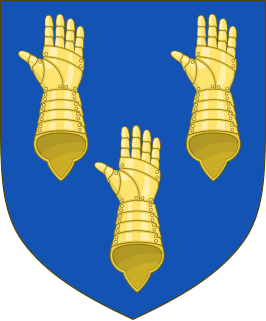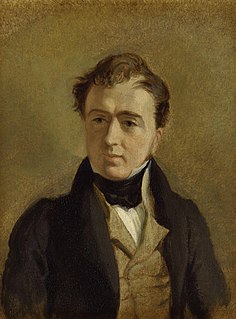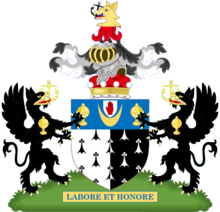
Baron Inglewood, of Hutton in the Forest in the County of Cumberland, is a title in the Peerage of the United Kingdom.

Earl of Rosslyn is a title in the Peerage of the United Kingdom. It was created in 1801 for Alexander Wedderburn, 1st Baron Loughborough, Lord Chancellor from 1793 to 1801, with special remainder to his nephew Sir James St Clair-Erskine, as Wedderburn had no surviving issue of his own. Wedderburn had already been created Baron Loughborough, of Loughborough in the County of Leicester, in the Peerage of Great Britain in 1780, with normal remainder to the heirs male of his body, and Baron Loughborough, of Loughborough in the County of Surrey, in the Peerage of Great Britain in 1795, with the same remainder as the earldom. The 1780 barony became extinct upon his death, but the 1795 barony and the earldom passed, by the special remainder, to his nephew, who thus became the second Earl of Rosslyn. The second Earl was a Lieutenant-General in the Army and also held political office as Lord Privy Seal and Lord President of the Council.

Earl of Onslow, of Onslow in the County of Shropshire and of Clandon Park in the County of Surrey is a title in the Peerage of the United Kingdom. It was created in 1801 for George Onslow, 4th Baron Onslow.

Earl of Romney is a title that has been created twice.

Earl of Limerick is a title that has been created twice in the Peerage of Ireland, associated first with the Dongan family, then with the Pery family.

Earl of Selborne, in the County of Southampton, is a title in the Peerage of the United Kingdom. It was created in 1882 for the lawyer and Liberal politician Roundell Palmer, 1st Baron Selborne, along with the subsidiary title of Viscount Wolmer, of Blackmoor in the County of Southampton. He had already been made Baron Selborne, of Selborne in the County of Southampton, in 1872, also in the Peerage of the United Kingdom. Both his son, the second Earl, and grandson, the third Earl, were prominent Liberal Unionist politicians. The latter was in 1941 called to the House of Lords through a writ of acceleration in his father's barony of Selborne. The third Earl's grandson, the fourth Earl, served as one of the ninety elected hereditary peers that remain in the House of Lords after the passing of the House of Lords Act 1999, and sat as a Conservative. As of 2021, the titles are held by the latter's son, the fifth earl, who succeeded his father in that year.

Baron Henley is a title that has been created twice: first in the Peerage of Great Britain and then in the Peerage of Ireland. The first creation came in 1760 in favour of Sir Robert Henley, Lord High Chancellor of Great Britain, when he was created Lord Henley, Baron of Grainge, in the County of Southampton. In 1764 he was further honoured when he was made Earl of Northington. On the death of his son, the second Earl, both titles became extinct. Lady Elizabeth Henley, youngest daughter of the first Earl and co-heiress of the second Earl, married the diplomat Morton Eden. In 1799, the Henley title was revived when Eden was created Baron Henley, of Chardstock in the County of Dorset, in the Peerage of Ireland. Their son, the second Baron, assumed the surname of Henley in lieu of Eden and notably published a biography of his maternal grandfather. His son, the third Baron, sat as Liberal Member of Parliament for Northampton. In 1885 the Northington title was also revived when he was created Baron Northington, of Watford in the County of Northampton, in the Peerage of the United Kingdom. This title gave the Barons an automatic seat in the House of Lords. The fourth baron Frederick Henley was an educated man who served as JP in Northamptonshire and married Augusta, daughter of Herbert Langham 12th baronet.

Baron Hesketh, of Hesketh in the County Palatine of Lancaster, is a title in the Peerage of the United Kingdom. It was created in 1935 for Sir Thomas Fermor-Hesketh, 8th Baronet, who had previously briefly represented Enfield in the House of Commons as a Conservative. As of 2010 the titles are held by his grandson, the third Baron, who succeeded his father in 1955. Lord Hesketh held junior ministerial positions in the Conservative administrations of Margaret Thatcher and John Major. However, he lost his seat in the House of Lords after the House of Lords Act 1999 removed the automatic right of hereditary peers to sit in the upper chamber of Parliament.

Baron Glenarthur, of Carlung in the County of Ayr, is a title in the Peerage of the United Kingdom. It was created in 1918 for the Scottish businessman Sir Matthew Arthur, 1st Baronet. He had already been created a baronet, of Carlung in the County of Ayr, on 28 November 1902. The title of the barony was derived from the joining of his mother's maiden surname name of Glen and his patronymic Arthur.
Baron Selsdon, of Croydon in the County of Surrey, is a title in the Peerage of the United Kingdom. It was created on 14 January 1932 for the Conservative politician Sir William Mitchell-Thomson, 2nd Baronet. His son, the second Baron, was a successful racing driver, winning the 1949 24 Hours of Le Mans in the first Ferrari. As of 2009 the titles are held by the second Baron's only son, the third Baron, who succeeded in 1963. He is one of the ninety elected hereditary peers that remain in the House of Lords after the House of Lords Act of 1999. Lord Selsdon sits on the Conservative benches. The Mitchell-Thomson Baronetcy, of Polmood in the County of Peebles, was created in the Baronetage of the United Kingdom on 26 September 1900 for the first Baron's father, Sir Mitchell Mitchell-Thomson, Lord Provost of Edinburgh from 1897 to 1900.

Baron Northbrook, of Stratton in the County of Southampton, is a title in the Peerage of the United Kingdom. It was created in 1866 for the Liberal politician and former Chancellor of the Exchequer, Sir Francis Baring, 3rd Baronet. The holders of the barony represent the genealogically senior branch of the prominent Baring family. The name Northbrook is derived from a tithing of the local parish.
Baron Swaythling, of Swaythling in the County of Southampton, is a title in the Peerage of the United Kingdom. It was created in 1907 for the British Jewish Liberal politician, banker and philanthropist, Sir Samuel Montagu, 1st Baronet. He had already been created a Baronet, of South Stoneham House in the County of Southampton and of Kensington Palace Gardens in the County of London, in 1894. As of 2010, the titles are held by his great-great-grandson, the fifth Baron, who succeeded his father in 1998.

Baron St Helens is a title that has been created three times, once in the Peerage of Ireland and twice in the Peerage of the United Kingdom.
Baron Palmer, of Reading in the County of Berkshire, is a title in the Peerage of the United Kingdom. It was created in 1933 for the businessman and patron of music, Sir Ernest Palmer, 1st Baronet. He had already been created a baronet, of Grosvenor Crescent in the City of Westminster, in the Baronetage of the United Kingdom on 26 January 1916. The Palmer family had made its fortune from their ownership of the firm of Huntley & Palmers, biscuit manufacturers, of Reading. As of 2017 the titles are held by the first Baron's great-grandson, the fourth Baron, who succeeded his uncle in 1990. He is the son of the Hon. Sir Gordon Palmer, Lord Lieutenant of Berkshire from 1978 to 1989, younger son of the second Baron. Lord Palmer is one of the ninety elected hereditary peers that remain in the House of Lords after the passing of the House of Lords Act 1999, and sits as a cross-bencher.
Baron Mancroft, of Mancroft in the City of Norwich, is a title in the Peerage of the United Kingdom. It was created in 1937 for the Conservative politician Sir Arthur Samuel, 1st Baronet. He had already been created a Baronet, of Mancroft in the City of Norwich in the County of Norfolk, in 1932. His son, the second Baron, was also a Conservative politician. In 1925 he assumed by deed poll the surname of Mancroft. As of 2010 the titles are held by the latter's only son, the third Baron, who succeeded in 1987. He is one of the ninety elected hereditary peers that remain in the House of Lords after the passing of the House of Lords Act of 1999. Lord Mancroft sits on the Conservative benches.

Baron Croft, of Bournemouth in the County of Southampton, is a title in the Peerage of the United Kingdom. It was created on 28 May 1940 for the Conservative politician Sir Henry Page Croft, 1st Baronet. He had already been created a baronet of Knole in the Borough of Bournemouth in the County of Southampton in the Baronetage of the United Kingdom on 28 February 1924. Croft was the grandson of Reverend Richard Croft, third son of Dr. Sir Richard Croft, 6th Baronet, of Croft Castle. As of 2010 the titles are held by the first Baron's grandson, the third Baron, who succeeded his father in 1997.
Baron Rotherwick, of Tylney in the County of Southampton, is a title in the Peerage of the United Kingdom.
Baron Renwick, of Coombe in the County of Surrey, is a title in the Peerage of the United Kingdom. It was created on 23 December 1964 for the businessman and public servant, Sir Robert Renwick, 2nd Baronet. He notably worked for the Air Ministry and the Ministry of Aircraft Production during the Second World War. The Renwick Baronetcy, of Coombe in the County of Surrey, was created in the Baronetage of the United Kingdom on 28 June 1927 for his father, Harry Renwick. As of 2020 the titles are held by the first Baron's grandson, the third Baron, who succeeded in that year. The second baron was active in the House of Lords until the House of Lords Act 1999, when he lost his seat in parliament.

Charles Greenway, 1st Baron Greenway, known as Sir Charles Greenway, 1st Baronet, from 1919 to 1927, was a British businessman.

Earl of Arran is a title in the Peerage of Ireland. It is not to be confused with the title Earl of Arran in the Peerage of Scotland. The two titles refer to different places: the Aran Islands in Ireland, and the Isle of Arran in Scotland. The Irish earldom is held by the Gore family. The Scottish earldom is a separate title, held as a subsidiary title of the Duke of Hamilton.












